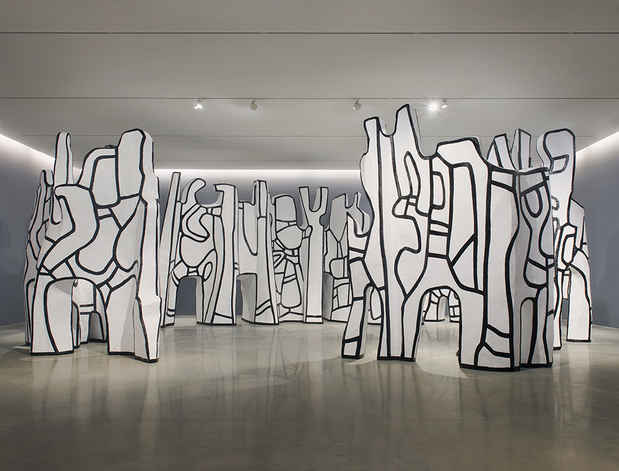Jean Dubuffet “Le cirque”
Pace Gallery (540 W 25th St.)

This event has ended.
During his decade-long involvement in the Hourloupe cycle, Jean Dubuffet prepared models and precise specifications for architectural completion. Le cirque, a black and white environmental sculpture, is one of the most major works of that cycle.
Le cirque is a habitable environment that suggests an urban plaza, which Dubuffet first conceived and sculpted in 1970 as a model for future enlargement at architectural scale. Measuring thirty feet square and thirteen feet in height, Le cirque is one of the last remaining works from the late-1960s and early-1970s to be realized at heroic size. Marking a crucial moment in Dubuffet’s deeply influential oeuvre, it stands as a major achievement in the artist’s sculptural practice and heralds the final chapter in his celebrated Hourloupe cycle, which lasted from 1962 to 1974. This cycle, the longest and most prolific of Dubuffet’s career, began with drawings and paintings, to which Dubuffet added reliefs to expand their presence spatially and “give them life,” as the artist stated. This evolved further into painted and sculpted panels, which came together in ambitious sculptural and architectural installations.
The original model for Le cirque was created shortly after Dubuffet’s second solo exhibition with Pace Gallery in New York in 1970, which debuted a body of new black-and-white sculptures called Simulacres. Dubuffet’s inaugural exhibition with Pace had taken place in 1968, after the artist met the gallery’s founder Arne Glimcher for the first time in Paris in 1966 and began working with him the following year. A foundational figure in the gallery’s history, Dubuffet’s work has been the subject of more than 20 solo exhibitions at Pace since 1968 and has been featured in countless dual and group exhibitions.
If Dubuffet teaches anything, it is that there are no conclusions, and no true beginnings… There is only the middle, the presentness of life.
-Peter Schjeldahl
In a letter to Pace’s founder Arne Glimcher two months before the opening of the Simulacres show, Dubuffet directly linked the “meandering, uninterrupted and resolutely uniform line” of the sculptural works to the Hourloupe paintings of the previous years. Employing the same language of linear black-and-white shapes that comprise the Simulacres sculptures, the model for Le cirque—completed the following year—imagines a monumental environment that immerses the viewer in what Dubuffet calls “a continuous, undifferentiated universe” of form. Deeply influenced by the modern streetscapes of post-war Paris, Le cirque registers the particular significance of the frenetic movement of traffic and bodies as established in the Paris Circus period (1961-1962) of the artist’s practice.
Working in his new studio at Périgny-sur-Yerres on the outskirts of Paris, Dubuffet determined the eventual form for Le cirque by manipulating individual sculptural units used for previous large-scale works into alternate configurations, which he documented with photographs and notes in his studio albums. The five individual units that compose Le cirque had previously been used by Dubuffet in the sculpture Eléments d’architecture contorsionniste (1969). By re-combining such elements into a new configuration, “an environment is formed,” explains Dubuffet, “consisting of mental elaborations and subsequently a new kind of architecture…made from allusions and evocations and belonging to the mental rather than the physical register.”
Translating the language of painterly abstraction into a colossal and immersive sculpture, Le cirque offers a slice of Dubuffet’s “undifferentiated universe” without beginning or end. For the artist, it was a world often populated by various figures that proliferated in both his paintings and sculpture, their writhing forms engaged in seemingly ceaseless motion. With Le cirque, the viewer becomes a surrogate for Dubuffet’s restless figures. Later, these same figures would spring to life in the 1973 production of Coucou Bazar at the Guggenheim Museum, which marked the final stage of the Hourloupe works. “If Dubuffet teaches anything,” the critic Peter Schjeldahl once reflected, “it is that there are no conclusions, and no true beginnings… There is only the middle, the presentness of life.” At Pace, viewers will be able to step off the streets of New York and into a corner of the artist’s alternate universe.
Jean Dubuffet began painting at the age of seventeen and studied briefly at the Académie Julian, Paris. After seven years, he abandoned painting and became a wine merchant. During the thirties, he painted again for a short time, but it was not until 1942 that he began the work which has distinguished him as an outstanding innovator in postwar European painting. Dubuffet looked to the margins of the everyday—the art of prisoners, psychics, the uneducated, and the institutionalized—to liberate his own creativity, coining the term “Art Brut” as a reflection of the creative possibilities outside the conventions of the day. His paintings from the early forties in brightly colored oils were soon followed by works in which he employed such unorthodox materials as cement, plaster, tar, and asphalt-scraped, carved and cut and drawn upon with a rudimentary, spontaneous line.
Media
Schedule
from September 18, 2020 to October 24, 2020